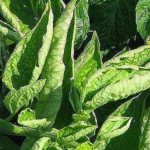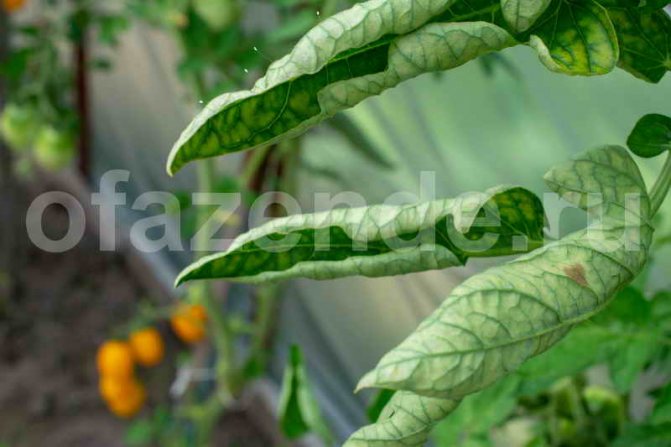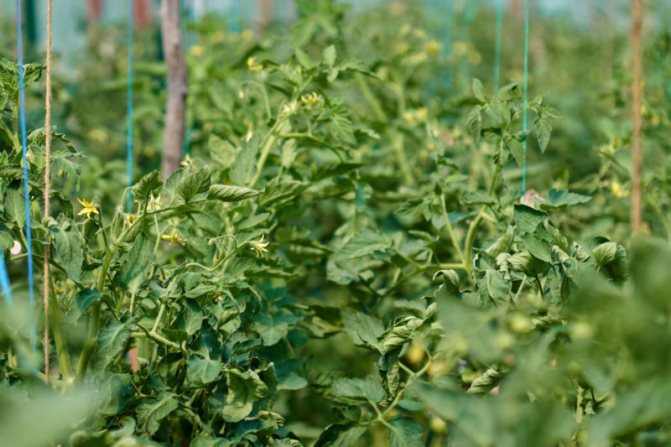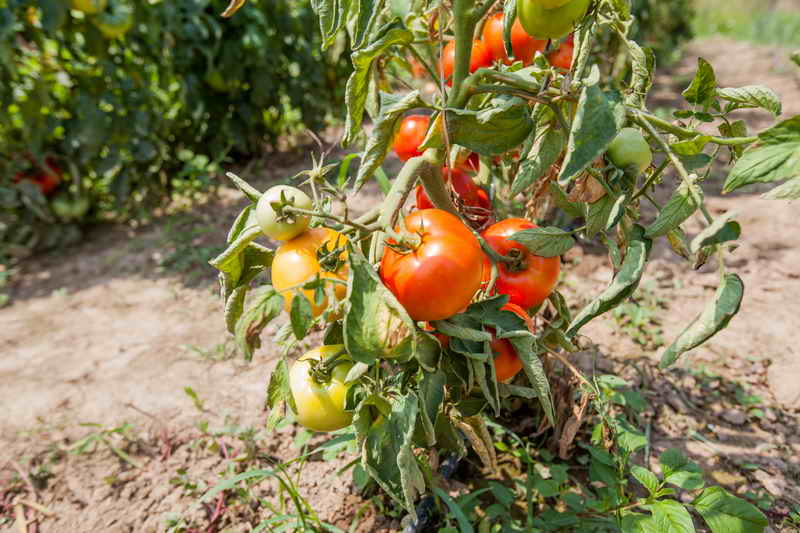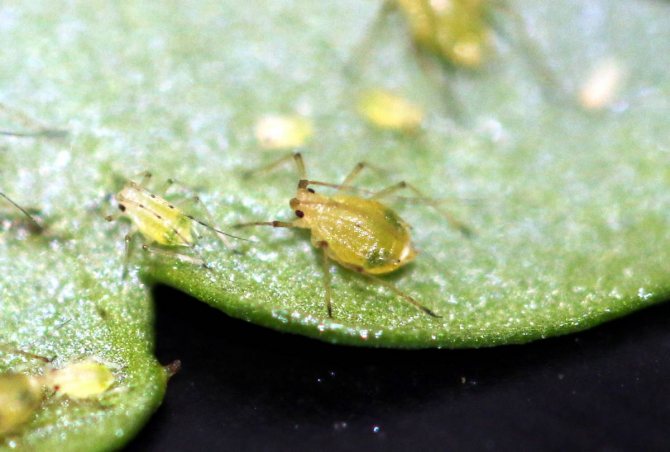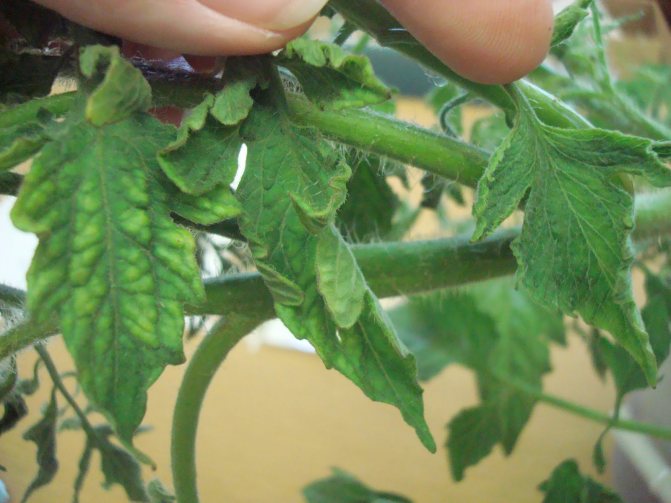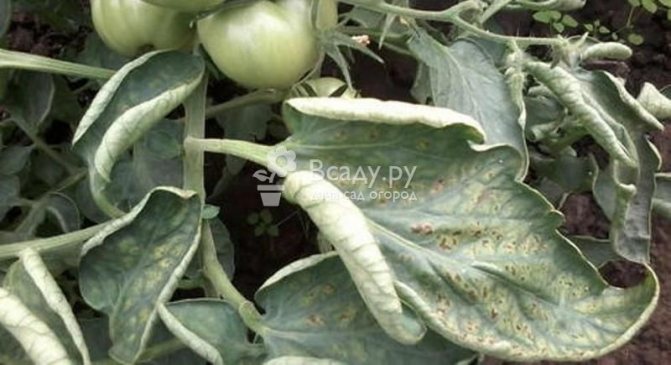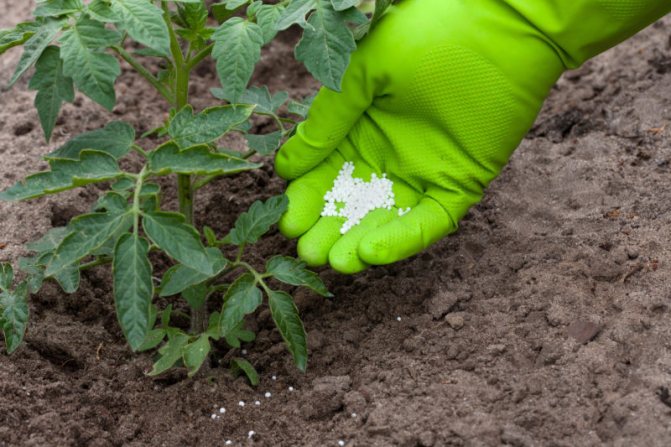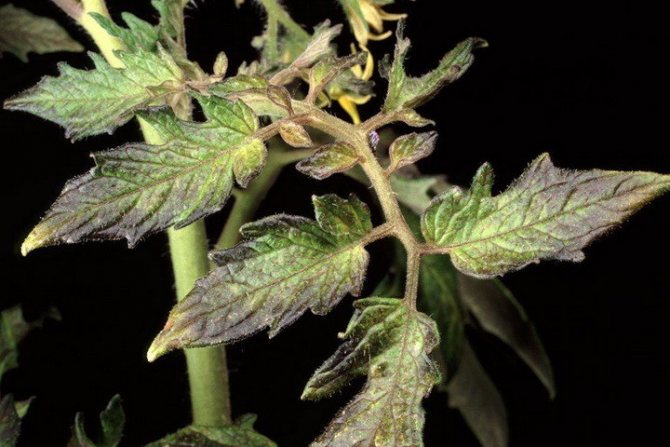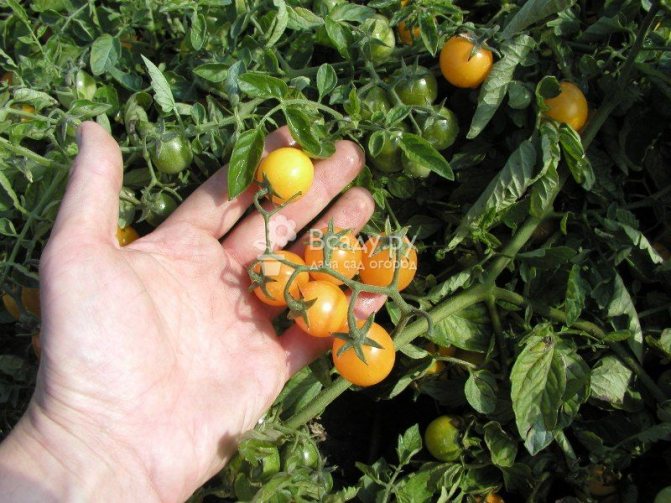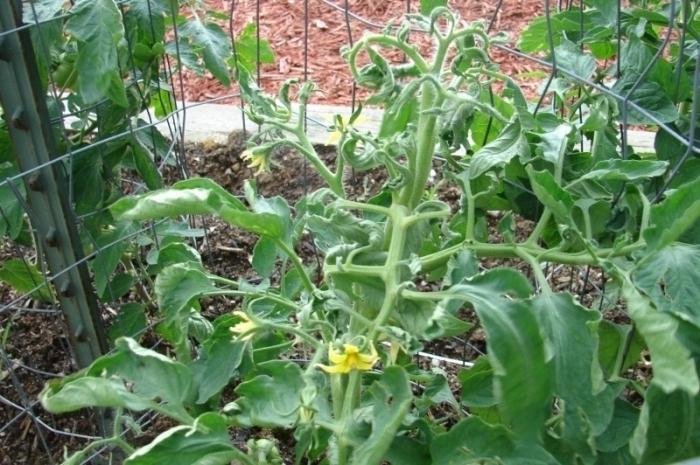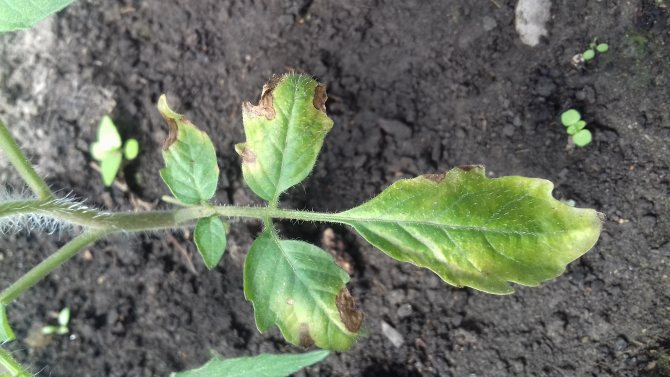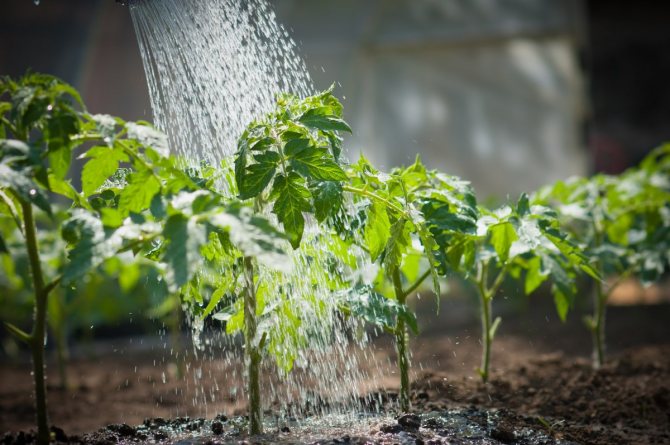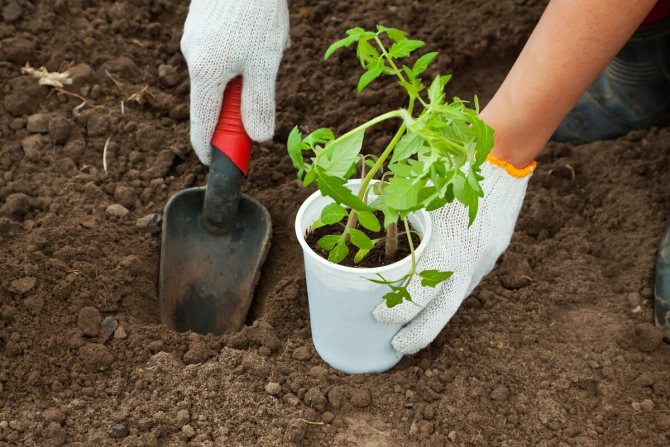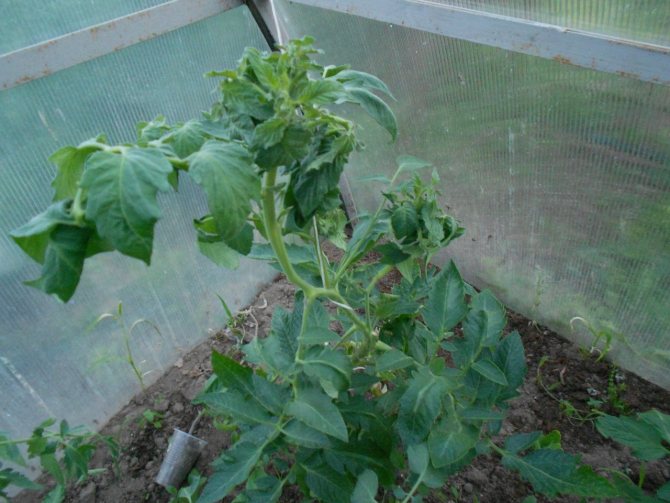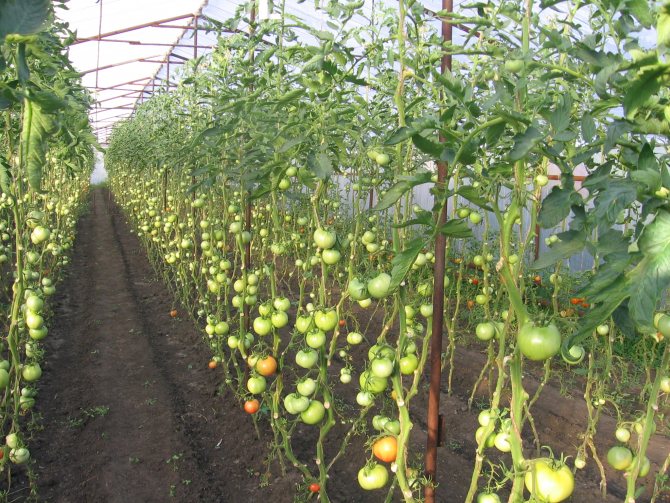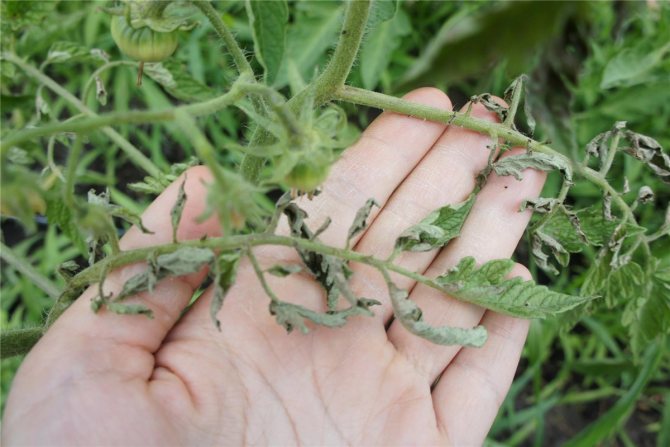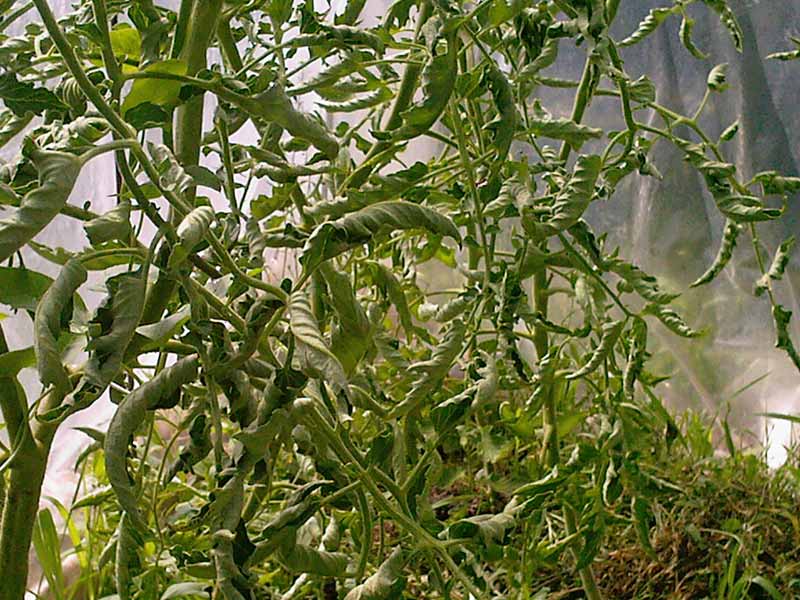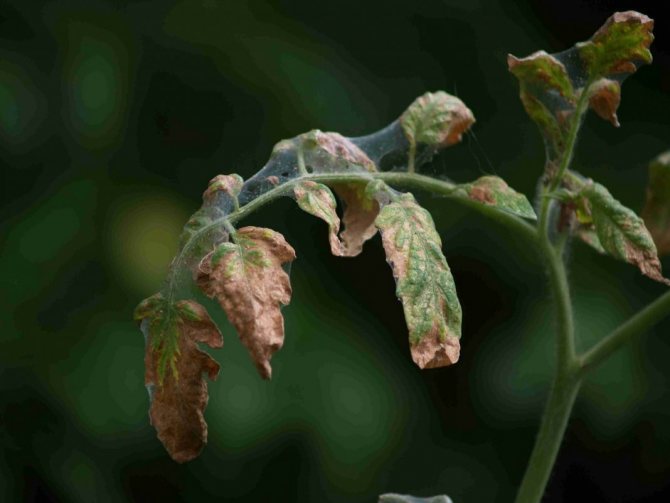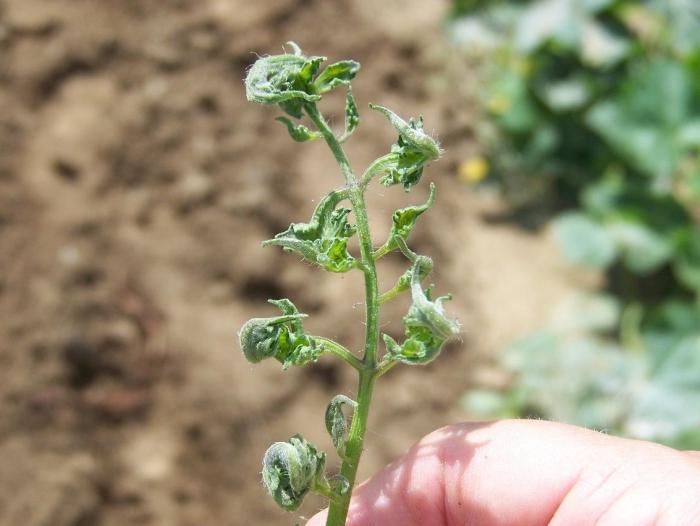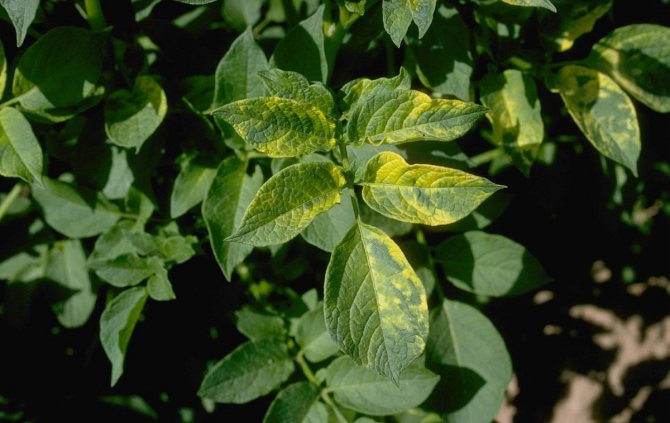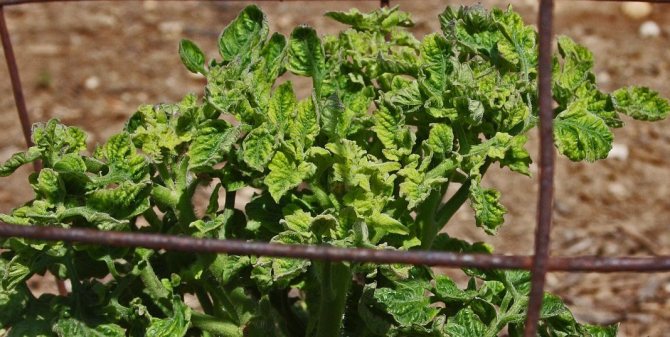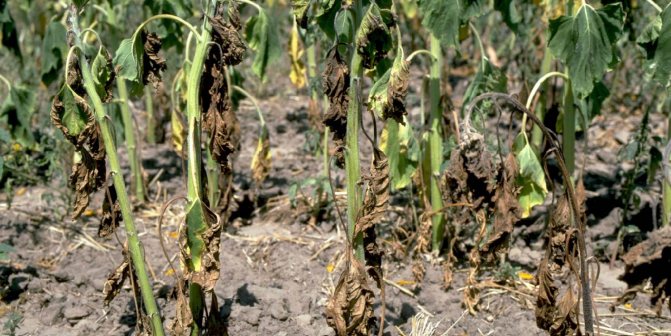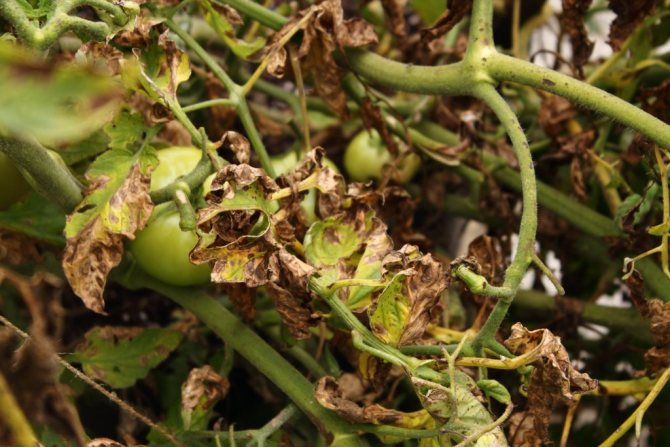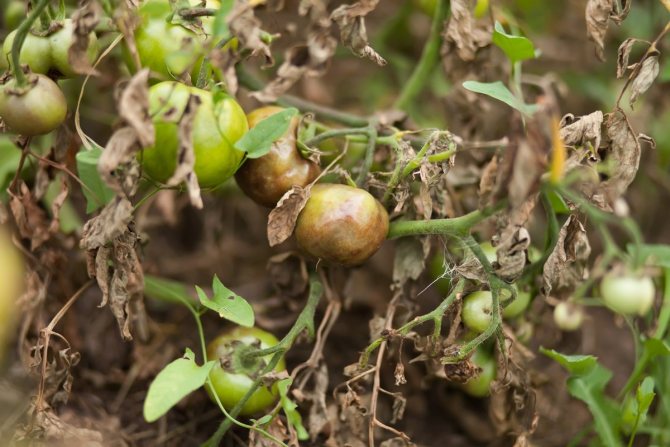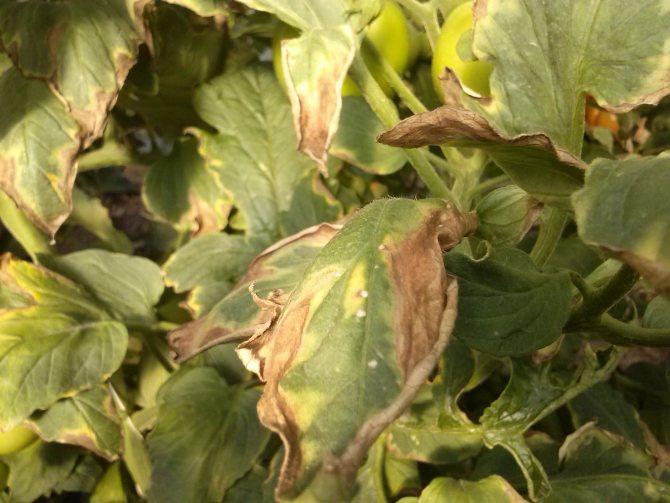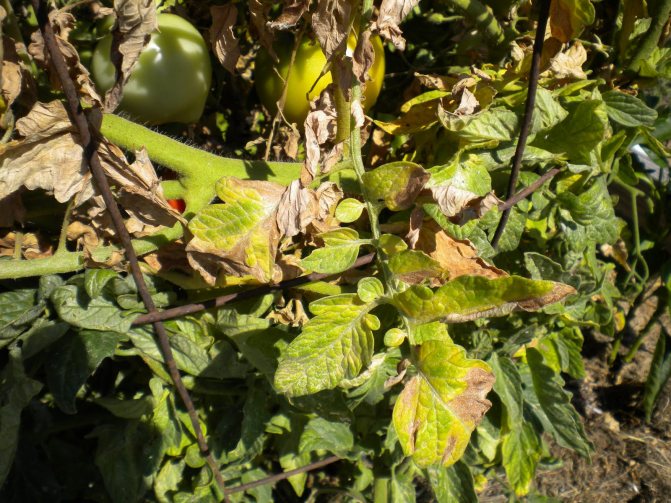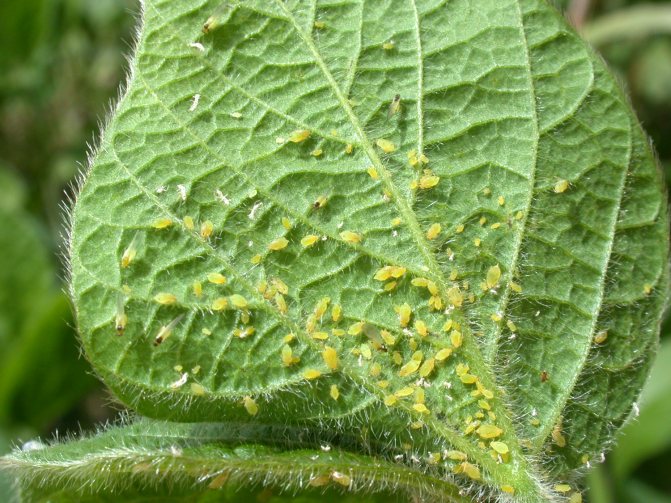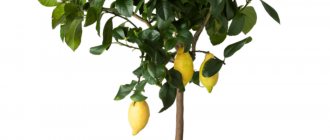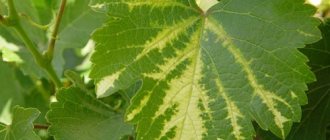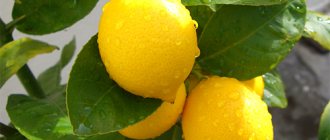Leaf curling in tomatoes is a common problem when growing in greenhouses. In the open field, such a nuisance is less common.
.
Agricultural engineering errors
Non-infectious diseases of tomatoes are local in nature. They are not transmitted to other plants. And when correcting shortcomings in agrotechnical care, tomatoes recover without infecting neighboring plants.
To the question: Why do tomato leaves curl? it is impossible to answer unequivocally. But, most often, the reason for this is improper agricultural technology.
Since the treatment of tomatoes will directly depend on the cause of the disease, the first step is to find out why the leaves of the tomatoes curl.
Insufficient soil moisture
Very often, the leaves on tomatoes begin to wilt and curl for reasons such as insufficient watering. In this case, the tomatoes themselves cause their leaves to curl. After all, this will reduce their area, which means that less water will evaporate from the surface of each sheet.
How can this problem be treated? To prevent the death of tomatoes, they just need to be watered. Watering tomatoes should be done correctly:
- do this at least once a week;
- even in severe drought, you should not water the bushes more often 2-3 times a week;
- at least 1 bucket of water must be poured under each bush;
- you need to make sure that water does not get on the leaves and stems of the tomatoes;
- when the fruits begin to pour in, the number of watering is reduced, otherwise the tomatoes will crack;
- it is better if the water for watering tomatoes is warm and settled.
| After a drought, when the leaves are already withering and curling, watering cannot be resumed abruptly - this must be done gradually, otherwise you can harm the tomatoes. |
Too much watering
An excess of water is as dangerous as a lack of it. Tomato leaves begin to curl, look lifeless and weak. It is easy to recognize the problem:
- Firstly, you need to inspect the soil: if it is wet, then the problem is not from drought;
- Secondly, tomato stems when waterlogged become fragile, and not lethargic;
- third, during drought, the leaves curl inward, and when waterlogged, the edges of the tomato leaves are wrapped outward, that is, up.
On the ground, such a problem appears during periods of strong and prolonged precipitation.
| In a greenhouse, tomato leaves can curl simply from increased air humidity, and not only due to abundant watering. In this case, the treatment of tomatoes consists in airing the greenhouse. |
In a situation with waterlogged soil, the following can be recommended:
- Temporarily stop watering tomatoes.
- Stretch a film over the beds to protect the tomatoes from precipitation.
- Plant tomatoes in loose, well-permeable soil.
Good soil for tomatoes should contain large elements, it can be river sand, peat, sawdust. All this will help the water to quickly be absorbed into the ground and go into deeper layers. If the tomato beds are in the lowlands, you can add a handful of sand to the hole so that the roots of the tomatoes will not be constantly in the water.
High air temperature
It often happens that the leaves of a tomato curl from extreme heat. Both in the garden beds and in greenhouses on the hottest summer days, tomato leaves can curl into a tube relative to the central vein.
| If the tomatoes are affected by the heat, check the leaves at night.When the air cools a little at night, the leaves unfold. |
Sunburn
In hot, dry and sunny weather, plants can get sunburn, which manifests itself as whitish spots on the fruits. Tomato fruits stop developing, become lumpy, dense and tasteless.
If the weather is sunny for a long time, it is necessary to protect the plants with any materials that prevent direct sunlight. For example, a canopy made of film, covering material and other shading methods.
Leaves are folded near seedlings
Cotyledon foliage curls after new growth, this phenomenon is not considered an anomaly. After planting in a permanent place, the leaves sometimes do not look fresh, lethargic - this is an adaptation to a different habitat.
Read:
15 interesting facts about mushrooms
There are varieties whose seedlings grow curled leaves that look like a "chicken foot":
- Cherry varieties;
- Fatima;
- "Japanese crab";
- "Honey drop".
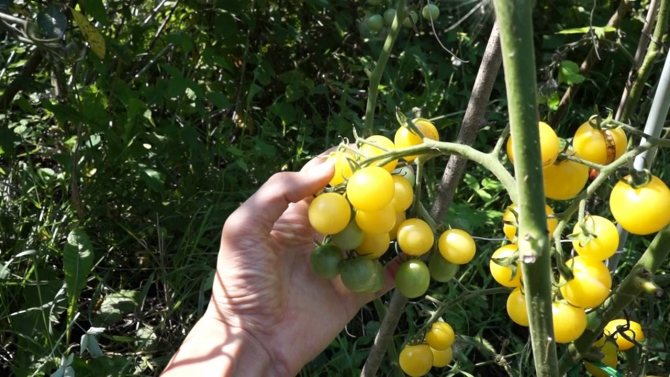
In this case, the woven tops does not mean that the plants are sick. If the leaves are the same, do not dry, do not deteriorate or fall off, this is a normal sign.
To check if there is enough liquid, you will have to “sacrifice” one plant. Pull it out and look at the result:
- Water remains at the bottom of the tank - an indicator that the drainage system has to be normalized;
- The ground is dry - change the watering mode.
Fresh air is essential, as is a light breeze. But drafts are harmful to harden the seedlings, in the first warm days it is recommended to take the sprouts outside.
Rolling tomato leaves in a greenhouse
You can help greenhouse tomatoes when curling leaves like this:
- ventilate the greenhouse and even arrange drafts - tomatoes are not afraid of them;
- mulch the soil in the beds with tomatoes with a thick layer of organic matter (sawdust, humus, straw, spruce needles);
- create a shadow over the bushes using opaque covering materials;
- every evening spray on tomatoes a solution of urea, 1.5 tablespoons per 10 liters of water or pale pink potassium permanganate.
Leaves curl due to pests
In addition to agrotechnical errors, the cause of leaf folding may be the appearance of insect pests:
- Whiteflies;
- Aphids;
- Spider mite.
Whitefly prefers the undersides of the leaves of tomato bushes. If you do not fight it, then first black spots appear on the leaves, and then they curl and dry out.
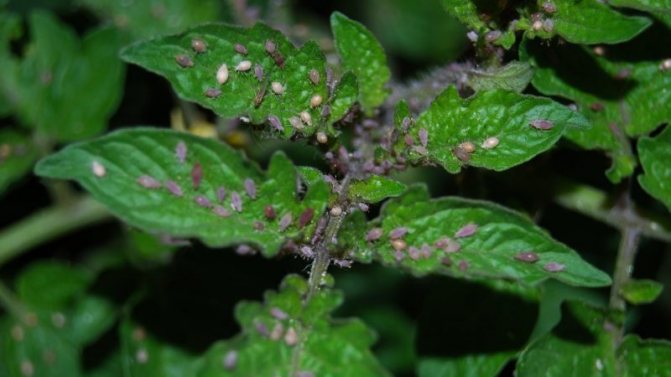

Whitefly larvae
If you notice this pest, then treat the tomato bushes with insecticides. "Fufanon" and "Mospilanom"... These are very effective preparations, but they can be used no later than three weeks before harvest. This is necessary so that the poison is completely gone from the tomatoes.
If the whitefly appeared after this period, then use folk remedies. For example, an infusion of yarrow, celandine or garlic and a soap solution.
IMPORTANT! To completely get rid of the whitefly, you need to carry out several preventive treatments per season.
Aphid dangerous because it feeds on plant sap. It literally sucks the vitality from the tomatoes, as a result of which the leaves wither, curl, and then the plant dies altogether.
Aphids can be easily spotted if the tomato bushes are inspected regularly.
Insecticides are effective against aphids Iskra, Aktara, Proteus... Sticky traps placed near tomato bushes also help.
Among the most effective folk remedies:
- soap solution;
- infusion based on celandine and garlic;
- ash solution (1 glass per bucket of water).
It is necessary to carry out processing of plants once every 7 to 10 days. More often, only folk remedies can be used.
REFERENCE. In the fight against aphids, the destruction of anthills located in the beds with tomatoes helps.
Spider mite most often affects tomatoes in greenhouses and hotbeds. The main signs of its appearance: twisted leaves, cobwebs, a change in the color of the stems.
You can fight spider mites with chemicals. Of insecticides, "Oberon" and Flumite.
As a prevention of the appearance of a spider mite, experienced gardeners advise treating tomato bushes with an infusion of henbane, garlic and dandelions.
Lack of batteries
The lack of trace elements in the nutrition of the bush is also often the reason that the leaves of tomatoes curl.
What mineral is lacking in tomatoes, the appearance of the bushes will tell you:
- if there is not enough phosphorus for tomatoes, their leaves turn down, turn gray-green, and the veins, on the contrary, acquire a bright purple-red hue.
- when tomatoes are deficient in potassium, their petals curl upward from the edge to the middle. Moreover, only young, upper leaves curl, and whitish spots may appear on the fruits.
The treatment of tomatoes in such situations is simple - you just need to make up for the lack of the necessary trace elements. For this, a phosphorus or potassium fertilizer is used (superphosphate and potassium nitrate, for example).
You can use wood ash, which contains both potassium and phosphorus, which are needed by tomatoes. It is necessary to stir the ash in a bucket of water and spray all affected bushes with this compound.
Excessive nitrogen in the ground can also cause tomato foliage to curl. You can find out about this by a too thick stem, along with small flowers or their complete absence. It is simple to rid the soil of excess nitrogen: you need to water the tomato beds abundantly with plain water.
Excess or lack of fertilizer
Without fertilizers, a good harvest of tomatoes cannot be obtained, many know this, but some, for fear of harming the plants, apply too little of them, while others, wanting to get the maximum yield, apply too much of them. Both of these lead to curling of the tomato leaf blades.
So, with an excess of zinc in the soil, the edges of the tomato leaf blade begin to bend. This can be confused with similar symptoms with a lack or excess of moisture, however, with an excess of zinc in the soil, the lower part of tomato plants becomes not typical for these plants, purple in color.
With an excess of manganese in the soil, tomato leaves first curl up, and then wrinkle and turn bright green.
With an excess of nitrogen in the soil, the leaf blades of plants begin to curl, usually at the top of the plants. To neutralize the effect of nitrogen, you need to add potassium sulfate (8-10 g per square meter) or wood ash (50-80 g for each plant) to the soil in a previously loosened and watered soil.
With a lack of elements, for example, calcium, the foliage of tomatoes begins to curl upward, this state of the leaf blades is often accompanied by the appearance of apical rot on the fruits. If it is rather difficult to eliminate the excess of zinc and manganese, then the lack of calcium can be easily dealt with by adding calcium nitrate to the soil. To do this, dissolve about 18-22 g of calcium nitrate in a bucket of water, adding 350-400 g of wood ash and 8-12 g of urea to the solution. This solution is enough for 3-4 square meters of soil under the tomatoes.
With a lack of phosphorus, tomato leaves also curl, but at the same time become grayish. In order to quickly restore the influx of phosphorus into plants, you need to add an aqueous solution to the soil, diluting 80-90 g of superphosphate in a bucket of water, this is the norm for 3-4 square meters of a garden bed occupied by tomatoes.
With a deficiency of copper, tomato leaf blades, in addition to curling, also acquire an atypical yellow color, sometimes become covered with yellowish spots, which can subsequently begin to turn black.They will help restore the balance of copper by treatment with copper-containing preparations - "HOM", "Oxyhom" and the like.


Tomato leaves turning blue and curling may indicate a lack of phosphorus.
Errors when pinching tomatoes
Experienced gardeners know that tomato bushes need to be shaped. This does not apply to all varieties and varieties of tomatoes. You need to remove the stepsons correctly, otherwise you can easily damage the bush and destroy most of the tomato crop.
It is necessary to approach the issue of pinching tomatoes competently:
- Young shoots are removed, the length of which does not exceed five centimeters.
- Too little stepchildren do not need to be cut off from tomatoes. This is necessary in order for the wound to heal faster if the "stump" is about a centimeter long.
- You need to step-by-step in the morning, so that the wounds on the tomatoes are weathered and tightened until the evening. The humid night climate encourages the spread of infections.
- On the eve of pinching, it is recommended to water the tomatoes, this will make their stems more fragile and it will become easier to remove stepchildren, and injuries will be minimal.
- It is advisable to do this with gloves or use a sterile instrument.
- The ragged stepchildren should be removed away from the tomato beds, as bacteria quickly develop in them.
If these rules of pinching are not followed, for example, too many shoots were removed at one time, or already overgrown stepchildren, more than 5 cm, were broken off, tomatoes experience severe stress. As a result, the leaves of tomatoes curl, they become lethargic and lifeless.
| As a result of mistakes during pinching, the leaves of tomatoes may curl. The bush spends energy on recovery and wound healing. As a result, tomatoes can even shed flowers and ovaries. |
To restore the plant after pinching, it is enough to provide the tomatoes with good care: airing, watering, not too hot climate. Then the tomatoes will recover faster and continue their development.
You can feed the tomatoes with a complex mineral fertilizer or use a good biostimulant for early recovery.
If the gardener does not have experience and knowledge, it is better not to carry out pinching at all. In this case, the tomatoes will be thickened, and the fruits will be small. This is better than losing the entire crop.
Why tomatoes curl: reasons
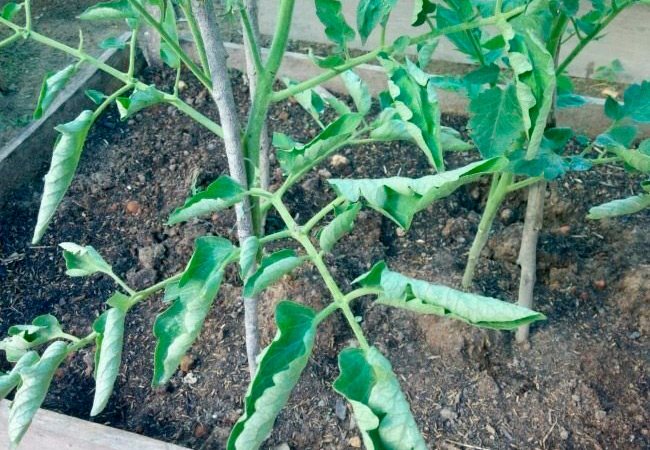

Green, strong leaves are an indicator that the plants are doing well and they are absolutely healthy. When the leaf plates begin to roll up (along the central veins, along the edges), curl into a "snail", this is a reason to be wary and watch the bushes.
All causes of the phenomenon can be easily divided into three groups:
Have questions? Ask and get useful advice from professional gardeners and experienced summer residents. Ask a question >>
- agrotechnical (care disorders);
- infectious (diseases);
- pests.
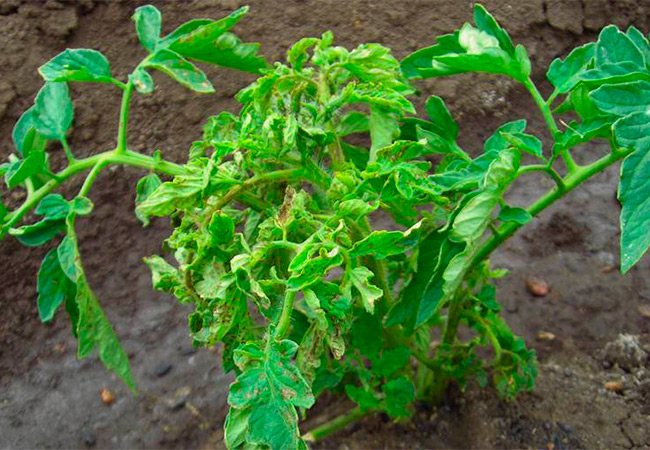

Loss of elasticity of leaf plates in case of illness is dangerous because the infection quickly spreads along the plantings. Without surgical treatment, crop losses will be significant.
It is a little easier to deal with pests and violations of agricultural technology. It is necessary to find out which insects are attacking the planting, and to find a suitable means of extermination (insecticides, folk recipes). In case of agrotechnical errors, changes are made to the schedules of irrigation, fertilizing, formation, airing is carried out correctly.
The reason is insect pests
Another reason why the leaves of tomatoes curl may be insect pests that suck the juice out of them. As a result, the leaf plate becomes thin and lifeless, dries quickly in the sun and is wrapped in a tube.
You can consider insects on the seamy side of the sheet - it is there that they most often hide. The most dangerous for tomatoes are considered such small pests as: aphids, red spider mites, whitefly larvae.
Rolling tomato leaves can add a couple more symptoms such as staining, yellowing, drying out and dropping off. In this case, the tomatoes should be treated with suitable insecticides as soon as possible.
How to spray a bush if the leaves of tomatoes are curled? - different preparations can be used at different stages of plant development. When there are no ovaries on tomatoes yet, chemically active substances and poisons are quite suitable: such insecticides act quickly and for sure, but they cannot accumulate in fruits.
If the fruits are already ripening on the bushes, and the leaves are twisted, you can try biological agents such as Fitoverm. Various folk recipes also help well, infusion of weeds (wormwood, ragweed and other weeds) is especially good.
Twisting due to disease
Various diseases can cause curling and deformation of tomato leaves.
Bacteriosis can be recognized by the fact that most of the leaves on the tomatoes are curled up. Shoots are small and weak, inflorescences are nondescript and small. The carrier of this disease is aphids.
In general, bacteriosis is incurable, but if it affects an adult plant, then there is a small chance to save the crop. To do this, you need to pinch the tops. But this method does not always help. If bacteriosis affects a young plant, then it must be dug up and burned, and the soil must be disinfected.
Bacterial cancer is an incurable disease. There are several signs of this disease:
- brown ulcers on the shoots;
- leaves roll up into a tube and dry quickly;
- the stems crack;
- brown marks on the cut of the lower leaves.
IMPORTANT! Bacterial cancer is transmitted through plant debris, so the affected tomatoes should be burned away from the garden.
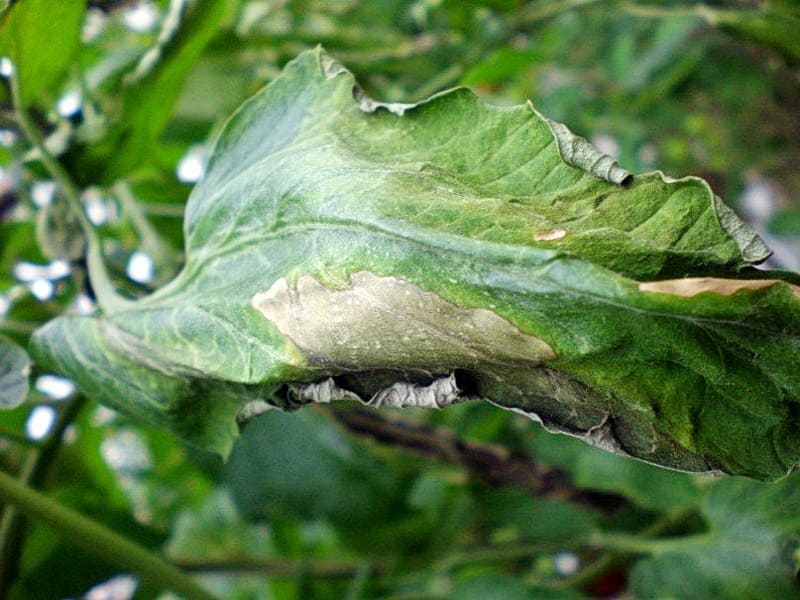

Tomato bacterial cancer
There is no cure for bacterial cancer. But there is a way to warn him. To do this, tomato seedlings are soaked in a solution for 2 hours before transplanting. "Fitolavina".
If only one tomato bush is ill, then the rest, for prevention purposes, must be treated with a Bordeaux mixture and "Fitosporin".
Fusarium most often manifests itself on the lower leaves. They are the first to curl up, after which the disease rapidly spreads along the rest of the leaves and shoots. Very soon they begin to die. Also, this disease affects the fruits, making them unusable.
In the fight against this disease, a solution of copper oxychloride, Bordeaux liquid, helps.
Diseases of tomatoes
The main causative agents of diseases in tomatoes are fungi, viruses and bacteria. They can be in the ground, move through the air, get on the plant along with water. Often the disease can be determined if the leaves of a tomato are curled, spots appear on the leaves or fruits. With severe damage, tomato leaves die off. If you timely determine the cause of the change on the leaves of tomatoes and take measures for treatment, you can save the crop.
The main types of tomato disease:
- Fungal infections
- Bacterial infections
- Viral infections
Let's consider the most common ones.
Treatment
First of all, you should determine the cause of the curling of the leaves. If the deformation is due to care errors, adjust watering, temperature, pinching.
With an excess of nitrogen:
- exclude nitrates from the diet of tomatoes;
- water the bushes well to wash out the nitrogen;
- outside the plan give phosphorus, potassium.
It is necessary to feed the tomato with fertilizers, in which there is a shortage. It is better to give trace elements in a complex manner. Spray the aerial part with chelates, adding epin to strengthen the immune system.
Copper is recommended to be given separately. Its deficiency leads to the development of phytophthora. Preparations containing the element are poorly combined with other chemical or biological agents.
If viral diseases or bacterial cancer are detected, the bush is destroyed. Pests - carriers of infections are fought with the help of appropriate insecticides.
Fungal diseases
Late blight
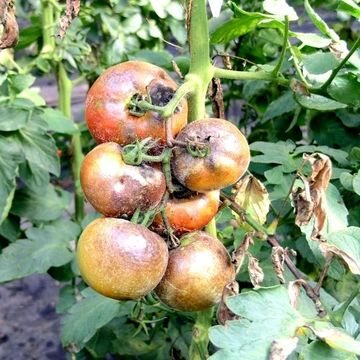

This is the most "popular" disease of tomatoes, it is expressed in the gradual darkening of parts of the plant.
A disease is harmful if it is not extinguished in time. It can destroy most of the crop. This tomato disease affects the aerial organs of the tomato. Dark plaque necrosis forms, after which the affected areas rot.
The pathogen accumulates, like many, in the soil and plant debris, and also settles on potatoes.
Preventive measures include: Agrotechnical: observance of crop rotation, use of stable hybrids Partner, Celsus, Semka 99 and Semko. Biological: Pseudobacterin-2 and Baktofit. Chemical: Agat-25, Quadris, Strobi.
Alternaria
Unwanted disease, because damage can be over half the crop.
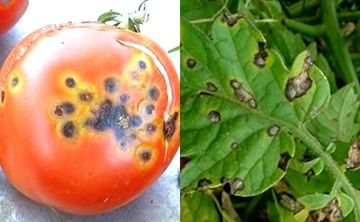

Single black spots are formed on the leaves, merging together over time. The same signs are on the fruits. Another form of the pathogen can also damage green fruits. The mushroom is preserved on post-harvest residues. The best conditions for Alternaria are high temperatures and high humidity. Changes in weather conditions also accelerate the development of this tomato disease.
Quadris at a concentration of 0.04 - 0.06% will be effective at the initial stage. It is better to use outdoors Ridomil Gold MC (2.5 kg / ha) and in the same amount Metaxil.
Anthractosis
The harmfulness depends on the growing conditions.
Tomato anthracnose disease is of two types - leaf and fruit. In the first case, the upper leaves wither, exposing the central stem. When the fruit is damaged, they become covered with dark depressed spots. Subsequently, fruit mummification is possible.
Disease Resistant Hybrids: F1 Life, Shelf, Longf. Recommend seed treatment Agatom-25spraying vegetative plants Quadris and Strobe... Hay stick preparations are effective.
Rhizoctonia
Root rot of tomato (Rhizoctonia disease). The harmfulness of this tomato disease in greenhouses occurs when tomatoes are grown on a substrate, and in open ground it is found in waterlogged areas. It develops throughout the life of the plant. The losses are relatively small.
Symptoms of root rot will be blackening in the area of the root collar and root - the so-called black leg. After the wilting of plants occurs. In some cases, infection with other diseases.
The maximum spread of the pathogen is obtained on non-sterile soil and with excessive watering.
It follows from this that the source of the disease is the soil or the substrate. Sometimes myceliums remain on the seeds.
The best way to prevent the development of root rot is to disinfect the soil and substrate, seedlings and seed dressing.
Processing can be carried out by all known 0.25% Ridomilom Gold... But this is in especially difficult situations.
Blackleg
It is harmless for greenhouse tomatoes, because in practice, it is very rare there. But outdoors it can do a lot of damage.
When the fruit has small lesions, it can become infected with wet rot.
Affected stems and fruits turn brown and soften. After a few days, they completely rot. Only the skin remains of the fruit.
As with most pathogens, these bacteria are good for temperature changes, high air humidity and temperatures of + 30 ° C.
Insects are carriers of infections. The pathogen has a wide range of damage, therefore, other plants can become sources of primary infection for tomatoes.
Those varieties and hybrids that have a generative growth gene will be resistant. In the field, the main method of dealing with blackleg is the destruction of insect vectors.
Temperature violation
On hot days, when a dry wind blows for a long time, tomato leaves curl inward. By curling, the plant reduces the area from which moisture evaporates. By the evening, the rolled leaves take their usual shape and during the night receive the missing moisture from the dew, replenishing the balance. What to do if there is hot dry weather for a long time and tomato leaves are curling? The best way is to shade the plant, helping its foliage to avoid curling.
You can throw the following materials on tomatoes during hot hours:
It is not recommended to water the plant in the sun, as the leaves can get burned from droplets of water. A good way to combat the described cause of twisting is to mulch the soil in tomato beds. What if the plant is not comfortable enough? You can cool the roots with a few centimeters of cut grass.


Bacterial diseases
Bacteriosis
The most dangerous disease of tomatoes, because is quarantine.
The biggest problem is the lack of symptoms visible to the eye. Tomatoes simply begin to wither quickly, after which they die. When the infection becomes chronic, the plants become underdeveloped, the color is unsaturated, the fruits are very small or do not form at all.
Since bacteria live in the soil, the plants become infected when they are planted. The disease spreads during the growth and development of plants and with drops of irrigation water.
The bacteria can be stored with potatoes. In the process of planting it, it is transferred to the tomatoes. Therefore, quarantine processing of greenhouses is a necessary measure.
Sick plants are destroyed, the rest are treated with 0.6 - 1.0% Fitolavin-300. You can also spray plants with this preparation with the addition of 0.15% water glass.
Stem necrosis
A fairly damaging disease under conditions of non-compliance with tomato cultivation.
Well-developed plants are affected first - brown spots appear on the stems, cracking over time. Soon the tomato wilts.
At 26 - 28 ° C, the growth of the pathogen will be maximal. When the temperature rises to + 41 ° C, bacteria will die. The primary source of infection is seed material, the secondary source is infected plants.
To prevent and prevent the development of stem necrosis, it is necessary to carry out a number of biological and chemical measures, as well as planting resistant varieties and hybrids, for example Red Arrow, F1 Resento and F1 Maeva.
Varietal feature
Some varieties of tomato twist leaves not because of some kind of disease, pest or lack of an element in the soil, but because this is their biological feature. The leaves curl to the greatest extent in the varieties: "Fatima", "Honey Drop", as well as in the overwhelming majority of cherry tomato cultivars.
Conclusion. When curled leaves appear in tomato plants, do not immediately grab onto chemistry or fertilizers, first assess the conditions in which your plants are located. It often happens that they simply lack moisture or, on the contrary, too much of it. Water if the soil is very dry, or stop if there is too much moisture in it; carry out pinching, and only if all this does not help, try fertilizing or carry out pest or disease control according to the schemes that we have described.
Post Views: 1
Viral diseases
Mosaic
A rather undesirable disease - the damage can be up to half of the harvest, sometimes the fruit does not form at all.
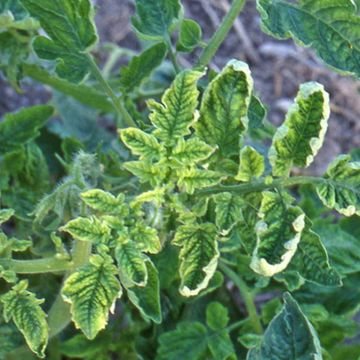

At first, the leaves are affected - they are deformed, covered with spots of green shades. Sometimes, this virus works in concert with other similar diseases, resulting in a streak disease. Mosaic virus is very resistant to environmental changes. It is carried by insects, seeds, plant debris and soil.
Resistant tomato hybrids have been developed: Semko-99, Semko-98, Partner Semko, Zhenaros, Kunero, Bella, Madison, Sors, Senzafin, Yvon, President, Anyuta.
It is very important to observe all the conditions for the normal development of culture.
Chlorotic curl
Chloritic curliness of tomato leaves manifests itself as a change in the color of the bush: from dark green it becomes light green, brightens. In addition, the top of the plant becomes curly (curly), and the growth and development of the bush is greatly slowed down.
This disease is caused by two viruses at once: tobacco necrosis simultaneously with tobacco mosaic. The method of transmission of the disease is through contaminated soil, seeds. That is why it is so important to pre-treat tomato seeds before planting, and in the greenhouse it is also very important to disinfect the soil.
The disease is very dangerous and, as a rule, an infected bush cannot be treated. It is dug up, and burned as soon as possible, until the infection spreads further.
Eliminate disease or pests
Before spraying or watering tomatoes with fungicides, you need to identify a disease or pest:
| Bacteriosis (bacterial cancer) Tomatoes grow slowly. The shoots are short, there are few flowers and they are very small. There are almost no ovaries. Leaves curl inward, dry. Dig the affected bush and burn it. Treat the rest of the plantings with copper chloride: 40 g per 1 liter. |
| Fusarium and verticillary wilting Fungal disease that affects the vessels of the plant. Leaves curl and dry out. You need to know what to do in this case, since the plant can die in 1-2 days. Dig up the diseased tomato and burn it. Cannot be composted or left on site. Treat the rest of the plantings with antifungal drugs and inspect well |
| Tobacco mosaic The leaves curl up, light green spots appear on them, which then turn yellow. The leaf plates become thinner. The disease does not respond to treatment. Dig up the affected plant and burn it. Spray healthy bushes with iodine solution: 15 drops of iodine in a bucket of water |
| Spider mite The leaves are entangled in cobwebs, curl down. Small light spots appear. Then the leaf plate dries up completely. Although the leaves look normal at the top, they then also curl and dry out. At the first sign, spray with a garlic solution. For severe damage, use Fitoverm |
| Aphid Tomato growth slows down, leaves and stems are deformed. You can identify the pest by examining the leaves from the back. Treat planting with garlic solution or chemicals |
Biological products for tomato protection
Trichodermin
It is used for powdery mildew (8 l / ha), late blight and alternaria with the addition of Gaupsin (5 l / ha + 5 l / ha of tank mixture).
Pseudobacterin-2
Used for protection against root rot, black leg, late blight and brown spot. Spray before planting and 2 times during the growing season with a concentration of 100 ml per plant and 10 l / ha.
Phytocid-R
Protects tomatoes from fungal and bacterial diseases, strengthens the immune system. Used as a pre-sowing treatment (for 100 g of seeds, 5 ml per 0.5 l of water), soaking seedlings (10 ml per 2 - 4 l of water) and spraying during the growing season (5 - 10 ml per 10 l of water at intervals of 10 days , 4 times).
Damage to the root system
When transplanting tomato seedlings from pots into the garden, it happens that due to carelessness, some parts of the roots of the plant are spoiled. Why do tomato leaves turn yellow and curl because of this? While the damaged areas of the root are regenerating, the tomato does not receive adequate nutrition, so the consequences are the same as when plants are starved. Over time, the rhizome is restored, the plant takes root, and the rolling of the leaves stops.
It is important to know that some varieties of tomatoes have a characteristic feature - their leaves rotate not due to diseases or unfavorable conditions, but are wrapped by nature. Among them are varieties such as Honey Drop, Fatima, cherry tomatoes.
Tomato protection chemicals
Quadris
(ae azaxistrobin, 250 g / l)
Effective against late blight, Alternaria and powdery mildew - 0.8 - 1 l / ha with an interval of 10 days, 3 times during the growing season.
Ridomil Gold MC
v.d.g. (d.v. mancozeb + mefenoxam, 640 + 40 g / kg)
The drug is prescribed for late blight and alternaria. Sprayed 4 times per growing season, 2.5 kg / ha.
Rinkozeb
(a.i. metalaxyl, 80 g / kg and mancozeb, 640 g / kg)
Used for alternaria and late blight of tomatoes - 2.0 - 2.5 kg / ha three times per season.
Strobe
v.d.g. (d.w. 500 g / kg kresoxim-methyl)
Diseases of tomatoes
Infections are another reason for discoloration, shape of leaf plates, curly leaves of tomatoes. Often, diseases arise due to improper agricultural technology:
- excessive watering;
- lack of ventilation for greenhouse plants;
- non-observance of the distance between the bushes when planting seedlings, thickened plantings in a greenhouse, in a garden bed, in a greenhouse;
- lack of pinning.
Bacterial cancer


With this dangerous disease, leaf slices wither and slightly curl upward. Then they turn yellow and dry out. It is possible to recognize that this is precisely a bacterial cancer by the brown sores appearing on the petioles, stalks, necrotic spots on tomatoes, stems.
The first signs appear on the lower tier, gradually the disease rises up and covers the entire plant.
Pillar


Phytoplasmosis (stolbur) is a dangerous disease at any stage of tomato development. They are transferred by leafhoppers, bugs, mainly from infected weeds.
On infected bushes, leaf plates turn yellow, deform. The border of the leaves rises upward, acquires a violet-lilac or pinkish color. The sheet begins to resemble a "boat" in shape. Stolbur affects the entire plant, including the matured fruits. Sick bushes cannot be saved, so they are removed from the ridge and burned.
Fitosporin
Progenitor: Bacillus subtilis, strain 26D. The titer is not less than 2 billion cells and spores / g. The spectrum of action of the drug is wide. The drug is recommended for the protection of potatoes, cabbage, cucumber and tomato both in commercial farms and in private household plots. Application methods for tomatoes: • during the growing season - against alternaria, brown spot, late blight (consumption 1.5-2 kg / ha), • dipping the roots of seedlings before planting - against bacterial cancer, soft rot, fusarium wilting, root rot.
Lack of pinning
Grazing is the removal of lateral loops, if it is not carried out, then the tomato plant will begin to actively branch. This leads to too much thickening of the plantings, the plants will form a lot of leaf mass, which is usually curled.
It is often difficult to correct this situation, especially if the plants are very neglected, therefore, tomatoes need to be pinned at a young age, when they tolerate this operation as painlessly as possible.
And remember, it is better to break out stepchildren, and not to cut and do it in the morning when the plants are in turmoil. In this case, the length of the stepsons should be no more than five centimeters.
Control measures for diseases and pests of tomatoes
- Charisma F1. Grown in greenhouses. High-yielding with fruits about 170 g. Resistant to cold weather, tobacco mosaic virus, fusarium and cladosporium;
Viral plant diseases in their external characteristics often resemble physiological disorders. In both cases, there is a change in the color of the leaves, their twisting and coagulation.
Whitefly
Rolling leaves for viral diseases of tomatoes
, Then this fungal disease first damages the lower leaves during flowering and fruit setting, and then the upper ones during the ripening of the berries. A tomato can become infected with such a disease in conditions of high air humidity (more than 70%). In order to prevent the appearance of this fungus, the gardener needs to regularly change the soil in greenhouses or greenhouses and burn plant waste. In addition, drugs such as "Fitosporin" or "Fundazol" are very effective.If you notice similar signs on some tomato bushes, be sure to remove those plants from the greenhouse. Treat the sections with a solution of copper oxychloride (60 g of the product per bucket of water), fill the root with abundant composition. All plants located on an area of 10 meters from the affected bush also need to be treated with a solution of copper oxychloride, only in a different concentration (40 g of funds per bucket of water).
How to get rid of pests? Seedlings should be treated with an insecticidal solution. A decoction of chamomile flowers or tobacco infusion will also help to cope with insects.If you notice twisted leaves on the seedlings, as well as a thickening of the stem, most likely there is an excess of nitrogen in the soil. Spreading the soil with stove or wood ash will help to remove it. Also spray the seedlings:
Diseases of tomatoes and the fight against them
Medvedka.Leaves and fruits of tomatoes are affected. First, small round brown spots appear on the lower surface of the leaves. Then they merge and take on an irregular shape.
Top rot.Streak (streak).
- Virtuoso F1. Easily tolerates humidity and sudden temperature changes, resistant to late blight. The fruits are large, do not crack, weighing 160 g. Tomatoes of this variety are grown in greenhouses;
Leaf-rolling virus (AFV) is caused by two viruses K and L:
Scoop
MacrosporiasisThe tobacco mosaic virus causes leaf curling in tomatoes. At the same time, you can notice a kind of mosaic pattern on them. Unusual bubbles that appear on the leaves are also a symptom of the disease.
If you notice that the leaves of tomatoes are curling, pay attention to the temperature inside the building. If it's higher than 35 degrees - that's the reason for you. Observing the plants during the day, when the temperature is high, and at night, when it drops, will definitely help to make sure of this. If the leaves really curl due to the heat, then at night, feeling a pleasant coolness, they will straighten.Ash solution (1 tbsp. Per bucket of water);
Large brown insect up to 5 cm long with powerful front legs and short elytra. It makes holes in the root layer of soil and makes holes at a depth of 10-15 cm. Medvedka gnaws at the roots of young vegetable crops and causes their death. To combat harmful insects, use the drug Thunder, an infusion of hot pepper or a vinegar solution.On fruits, spots similar at first become larger and darker, and the tissues around them brighten, forming a border.
As you can see in the photo, this tomato disease is characterized by the appearance of dark green weeping spots on the top of unripe fruits. The affected tissues darken and become hard, the fruits ripen faster. Sometimes signs of fetal damage are noted only on the cut. Low-lying fruits are most often affected. Plants are watered moderately and regularly. In autumn, dolomite flour, lime or chalk is added to the soil in the beds to replenish calcium. In the spring, when planting, deoxidizing fertilizers are added to the holes.Stems and fruits of affected plants are covered with yellowish spots in the form of stripes. In this tomato disease, the leaves become curled and drooping. Flowers and fruits crumble from diseased bushes. With extensive damage, the plants die completely. Insufficient illumination contributes to the development of the disease. To prevent the reproduction of this viral tomato disease, the culture is not planted next to other plants of the Solanaceae family, the distances between the plants are observed when planting.
- Bohemia F1. A low-growing hybrid that is grown in greenhouses and outdoors. Fruits reach 140 g. Resistant to major diseases;K virus (mosaic leaf curl) appears as a faint spotting and curling of the upper young leaves with waviness at the edges. It can also affect the root system without any symptoms.The virus is transmitted through seeds and contaminated soil;
The scoop is an insect that damages in whole or in part the leaves and stems of a tomato. This pest is quite common. In order to prevent its appearance, the gardener is recommended to spray the plant with the biological preparation "Strela". For its preparation, it is necessary to add 50 g of powder to 10 liters of water). In addition, the tomato owner needs to regularly clear the land of weeds and dig up the soil.In turn also contributes to leaf damage. This fungal disease is characterized by the formation of round brown spots, which soon merge. This is how the plant leaves die. In addition, macrosporiosis affects the stem and fruit. Dark round spots appear on the surface of the berries. The ideal environment for the habitat and spread of such a fungus is high humidity and strong winds. The main measure to combat this disease is to treat the plant with a copper-soap emulsion. To prepare such a tool, the gardener will need 10 liters of water, 200 g of soap and 20 g of copper sulfate. As for the already affected foliage, the most convenient and effective way to eliminate it is burning.
The leaves of tomatoes are curled as a result of a fungal infection - fusarium. In this case, the older, lower leaves are affected first. Gradually, the process moves higher and higher, eventually causing the upper shoots to wilt. If you notice signs of fusarium on the seedlings, it must be removed and burned, and the uninfected bushes must be treated with an antifungal agent. Do not ignore the disease and take preventive measures, otherwise all the plants in the greenhouse will die not only this year, but also next year.
Give your tomatoes fresh air and protect them from the sun by covering the greenhouse with a non-woven fabric and the problem will go away.
A solution of potassium sulfate or monophosphate (1 tsp per 10 liters of water).Wireworm.
Protecting tomatoes in pest control
First, the affected leaves wither, and then the whole plant. When the first signs appear, tomatoes are treated for this disease by spraying the plants with a solution of Bordeaux mixture, copper sulfate, and fed with fertilizers containing copper and nitrogen. Withering bushes are destroyed.Cladosporium (brown spot).
Verticillary wilting.- Opera F1. Grown in greenhouses. The plant is 1.5 m high and has an average of 100 g of fruits. Resistant to many diseases;
L. virus Most widespread in Europe. We deliver mainly Dutch seeds that have not been treated with antiviral drugs. In the first year of planting such seeds, the virus manifests itself exactly like the K virus. And the next year, the lower leaves are affected: they curl into a shuttle, and then into a tube. Further, the upper leaves are affected and as a result, everything loses its elasticity. The virus is not transmitted by contact from a diseased plant to a healthy one.As for the bear, this insect damages the stems and roots of tomatoes. To get rid of this pest, the tomato owner needs to use a remedy called "Thunder".
Summing up, it should be noted that there is no single method of dealing with leaf curling in tomatoes. First of all, you need to find out the cause and try to eliminate it. Take care of the plants in the greenhouse correctly, and then a rich harvest of tomatoes will delight you every year!
Tip: to remove the curl caused by heat, in tomatoes, treating the leaves with a urea solution will help. Dissolve 1.5 tbsp. l. medium in a bucket of water and carry out an evening treatment. And after a couple of days, spray the seedlings with a weak solution of manganese.If tomatoes lack:
The pest is a click beetle larva. They are distinguished by a dense yellow body, in length they do not exceed 2 cm.Wireworms damage the roots of tomatoes and sometimes invade the stems. 3-4 days before planting tomatoes, a pest bait is laid in the soil. Pieces of carrots, beets or potatoes are strung on sticks 16-20 cm long and buried in the beds. Before planting seedlings, the pest is destroyed. To protect tomatoes from these pests, use the drug Bazudin and lime acidic soils.Black leg.
In tomatoes, light gray blurry spots in the form of a velvety bloom appear on the underside of the leaves in the lower part. Then the spots become brown and spread to the upper part of the plant. Leaves with signs of the disease dry up and the plant quickly dies. To prevent the disease, seeds are pickled before planting, watering is done moderately. For the treatment of tomatoes, when the first signs of cladosporia appear, they are sprayed with Hom and Oxyhom preparations.

